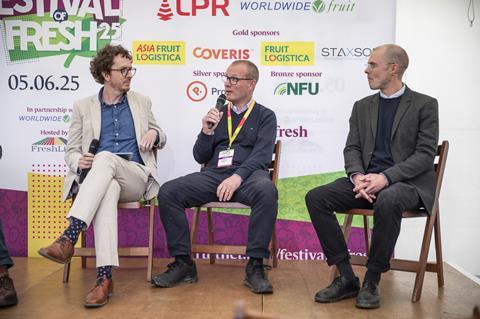Editor Fred Searle was joined by predecessors Michael Barker and Tommy Leighton on stage at Festival of Fresh to reflect on how the magazine has survived despite a tough publishing climate
The survival and success of Fresh Produce Journal (FPJ) has come from its ability to adapt to modern publishing trends while continuing to support the industry, according to former and current editors.

At a panel at FPJ’s Festival of Fresh earlier this month, editor Fred Searle was joined by two of his predecessors, Michael Barker and Tommy Leighton, to reflect on the magazine’s history as it celebrates its 130-year anniversary this year.
Leighton, whose tenure coincided with a major change in the fresh produce industry from wholesale to retailer-focused, recalled how the magazine had to adapt both its coverage and its publishing methods.
“As a publication, we were in a pickle because at that time we were closely associated with the wholesale industry,” he said, pointing out that fears the wholesale trade, as well as print publishing, would cease to exist have both proved unfounded.
Barker discussed the huge pressure on magazine revenues more widely as the online boom saw traditional advertising decline as digital publishing and social media began to dictate reading and spending habits.
“The publishing industry was in the doldrums. There used to be thousands of print publications in the UK – I lost my job twice when publications went bust,” he said.
“The fresh produce sector is very lucky because if you look at the other sectors, a huge number of those publications went under.”
Barker also pointed to the efficiency of staffing at FPJ compared to other industry titles, such as The Grocer and Farmers Weekly, with much higher numbers of journalists.
“To have come through that period has been an important process for the FPJ,” he added, pointing to early adoption of online publishing and events via parent company Fruitnet Media International as instrumental to financial survival.
Searle, who has been editor of FPJ since 2020, said he has seen the industry change again, with a huge uptake on professional networking platform LinkedIn now being a key part of FPJ’s digital strategy.
“In the last four years, we’ve really seen LinkedIn grow as a platform to share news, connect with readers and react,” he said.
“Having a quick take on something is important, but we’re proud to still publish a print publication and it’s great to see people enjoying that.”
Leighton recalled how the priority of digital over print began in his tenure, where the best stories that were traditionally saved for print began to published on the website first.
“It changed with a story about a fire at Wealmoor,” he said, recalling how he had felt the story was important enough to publish as soon as it broke on fpj.co.uk. “Previously, we could have saved stories for two weeks and no one would know about it,” he added.
Looking ahead, Searle said the magazine will celebrate its history this year alongside gearing up for the next era of its support for the sector. He confirmed the upcoming launch of a new FPJ podcast, set for release over summer and hosted by features editor Nina Pullman, who has returned to the magazine after eight years away covering consumer food issues.
Panel chair and managing director at Fruitnet, Chris White, shared his own memories of characters and business trips to key producer regions, as well as the standout covers and photos that have been published in FPJ over the years.
“FPJ is part of the industry and there’s nothing quite like it,” summarised Leighton. “Even now, I always say it’s the best job I ever had.”
A special 130th anniversary issue of FPJ will be published in September, and will celebrate the magazine’s history alongside key moments for the fresh produce sector.



